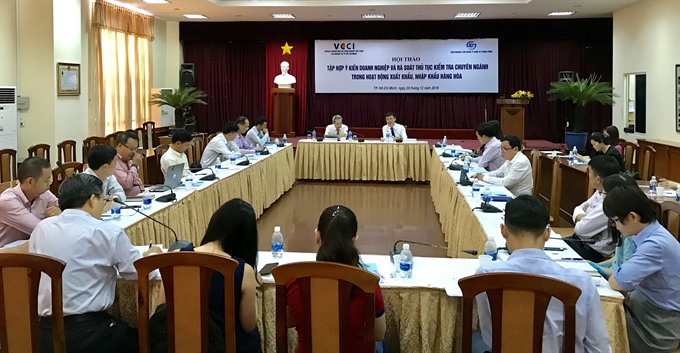 Economy
Economy

" />Experts have suggested changing the number of and the time spent for inspections of export activities, including customs clearance, to help reduce costs for enterprises.
 |
| Speakers at a seminar on inspections of export activities held on Thursday in HCM City. — VNS Photo Bồ Xuân Hiệp |
HCM CITY — Experts have suggested changing the number of and the time spent for inspections of export activities, including customs clearance, to help reduce costs for enterprises.
Speaking at a seminar held on Thursday in HCM City, Trần Ngọc Liêm, deputy director of the Việt Nam Chamber of Commerce and Industry (VCCI) HCM City, said that overlapping inspection procedures were causing problems for enterprises.
The General Department of Việt Nam Customs said that procedures accounted for up to 50 per cent of customs clearance time.
Many shipments have been inspected, but still have not been cleared, it said. Even after three months, State agencies are still conducting inspection checks.
Phan Đức Hiếu, deputy head of the Central Institute for Economic Management (CIEM), said the proportion of imports and exports subject to specialised inspections at customs clearance was up to 30-35 per cent and would be reduced to 15 per cent under a Government resolution.
The current rate of imported and exported goods subject to veterinary inspections is 14.3 per cent; quality control, 25.3 per cent; food safety inspection, 19.1 per cent; and export licences, 41.2 per cent.
As many as 100,000 export items are currently subject to specialised inspections, he said.
Resolution 19 of the Government identified the need for reform of sectoral management and control, and assigned a number of missions to several ministries.
So far, 60 documents have been reviewed, and 56 of them have been amended and supplemented, with four not amended or supplemented.
“As for the number of goods subject to specialised inspections, up to 58 per cent go through two to three test procedures, increasing costs for businesses,” Hiếu said.
Every year, enterprises have to pay VNĐ14.3 trillion for specialised inspections, according to the General Department of Việt Nam Customs.
Most businesses said that many ministries have a monopoly in carrying out conformity assessment inspections.
The inspections are still done manually and communication among information technology agencies is limited, without risk management procedures.
Even though the number of inspections is high, the detection rate is only 0.1 per cent.
The seminar was organised by VCCI in HCM City in collaboration with CIEM.
The seminar listened to opinions on the problems of exporters and reviewed specialised inspection procedures of export and import activities. — VNS




